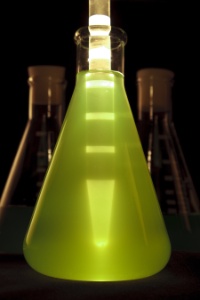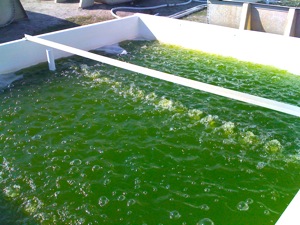Feb
27
Algae Sizzle and Algae Steak
February 27, 2009 | 6 Comments
First up is the sizzling Bionavitas “Light Rod” idea called Light Immersion Technology that looks like a giant tapered optical fiber that places light at depth into algae cultures. Ingenious as ideas go, with a near stunning amount of coverage on Wednesday the idea might get some financial and research legs. What has been left out is the details about the light. The photos seem to leave out the top of the rod or fiber or just show a shaft, whose top area sets the amount of light; no matter how deep it is distributed. The idea solves a problem in algae culturing, getting light deep so that the culture isn’t just a thin layer at the sunlit surface. But the hard fact is that the total light in is what matters, not just how deep its spread around.
On the other hand, concentrating the light over a larger area using lenses or mirrors or a combination could provide a higher volume of energy for the algae photosynthesis. That then raises the area issue. Algae and other biofuel yields are usually stated in units per land area. Sunlight is a matter of how much per land area. High intensity algae production is simply going to need sunlit area. Another glitch might be the effort to remove or clean the algae from not just the culture tank walls, but those rods, too.
But beyond sizzle, there is real meat in there to be found. Light concentration would reduce the total area need for tanked culture while the light gathering could enlarge production. A critical eye might suspect that the total investment per sunlit area might be reduced, with an increase in cycling tank expense. The real meat is yet to be found, but that’s a mighty compelling sizzle and scent to drive intense research.
Meanwhile, not so quietly, the algae business is launching with real steak from PetroAlgae outside of Fellsmere, Florida. PetroAlgae is nearly finished with their vertically integrated, scaleable, licensable 5-6,000 gallon per acre algae-to-energy production system. The PetroAlgae project is far enough along to be rated at better than a 50% chance of realizing an actual 5,000-gallon per acre yield, and doing so very soon. At that rate only 12 million acres, some 18,750 square miles, would produce enough biodiesel to replace all the diesel fuel consumed in the US in a year. A comparable is that area is less than half what is needed to supply 10 billion gallons of corn ethanol.
But that’s not the only company in the hunt. The four “S’s” Solix, Solazyme, Seambiotic and Sapphire are closing in on solutions too.
Today PetroAlgae has a 20-acre campus with tight 24-hour security on the south fringe of Florida’s Space Coast. So the description of the facility and the business model will have to do.
The campus is the site of an open-pond system now scaled to a 1/2 acre. The business model calls for individual units of just that size. An algae inoculum developed in the company’s lab is transferred to the pond where it blooms. Then inner baffles are used to create an eddy that turns the water over and creates uniform “cell light time”, sharing the sunlight evenly across the culture to avert a “crash” of the algae that halts blooming.
The company has 12 main algae strains, including some from Arizona State University, and none of them are genetically modified. The typical strains used in test production are now at 30-40 percent lipid content. The company reports that growth rate and doubling rates are where they need to be for a commercially viable system. The company has developed a lab sized continuous flow system to extract algae via pipeline and concentrate the algae down to 50 percent water content, or algae paste, but hasn’t gotten to building a commercial scale prototype, yet.
At this point the extraction technologies apply. Current solvent methods are expected to get oil to diesel and the remaining biomass for protein and carbohydrate for sale at near market prices.
What is in research is other ways to increase production or reduce costs. Piped in CO2 can enrich the growth medium along with nitrogen, phosphorous, iron and sulfur nutrients. PetroAlgae is so far along that it has leased lab space at NASA. Using an old Kennedy Space Center lab hangover from the Mission to Mars project some years ago, allows the company to simulate any combination of atmosphere and temperature, which allows it to precisely project yields for partner companies.
Right now PetroAlgae is finalizing local permits for the full-scale demonstration project to run over a 5-6 month period.
The business model has the company rich with customers, with some 80% offshore. Viability requires several hundred acres, but the company is modeling itself based on 12,500-acre parcels or groups that can assemble a parcel from individual interests. PetroAlgae has been working with prospective clients for the past 18 months, including testing water samples, modeling sunlight with their Kennedy Space Center Lab, and installing its own weather location system to provide more accurate data on wind speed and solar intensity. They expect to strike a licensing deal by the end of the first quarter. The model is fee + royalty, with payments graduated on the basis of productivity milestones.
PetroAlgae expects to sign its first licensees by the end of March. The production sites will hire a total of 500 employees per project, including native speakers, and technical, skilled and semi-skilled labor. PetroAlgae is guaranteeing productivity rates to attract capital and commercial interest and said it is down to technical and financial concerns before it announces its initial National partner. One can only wonder what the financial “crises” has done to the planning roadmap.
PetroAlgae (PALG.OB), also has developed a technology to concentrate power plant emissions, which average 12 percent CO2, to more than 50 percent concentration through a proprietary process that removes sulphur dioxides and mercury.
With a market cap of about $140 million, customers and technology that is reproducible, PetroAlgae looks to be real steak.
Algae oil is just about to take off at PetroAlgae, and the four “S’s” are hot behind. And there is a bunch of sizzle coming behind that!
Comments
6 Comments so far




using Electroporation to poke holes in the cell walls would extract those lipids without nasty solvents. What we need is a process where farmers can set up a couple of ponds where they can grow enough diesel and power their tractors.
[…] The rest is here: Algae Sizzle and Algae Steak | New bEnergy/b and Fuel […]
[…] Algae Sizzle and Algae Steak : Bionavitas “Light Rod” idea called Light Immersion Technology that looks like a giant tapered optical fiber that places light at depth into algae cultures. Ingenious as ideas go, with a near stunning amount of coverage on Wednesday the idea might get some financial and research legs. What has been left out is the details about the light. The photos seem to leave out the top of the rod or fiber or just show a shaft, whose top area sets the amount of light; no matter how deep it is distributed. The idea solves a problem in algae culturing, getting light deep so that the culture isn’t just a thin layer at the sunlit surface. […]
Hello my friend,How are you ? iam coming again to your blog :p Thanks
Terrific work! This is the body of answer that should be shared past The web. Shame going on The search the web engines being never positioning this content higher!
Pretty nice post. I just stumbled upon your blog and wanted to say that I have really enjoyed browsing your blog posts. In any case I’ll be subscribing to your feed and I hope you write again soon!